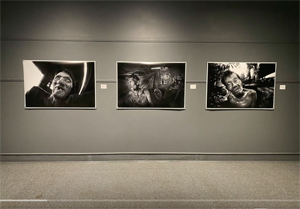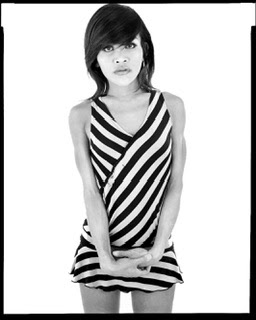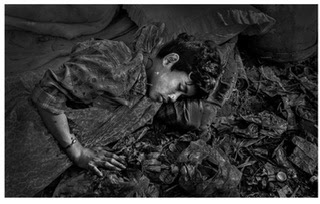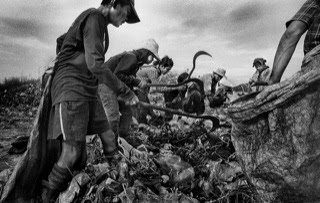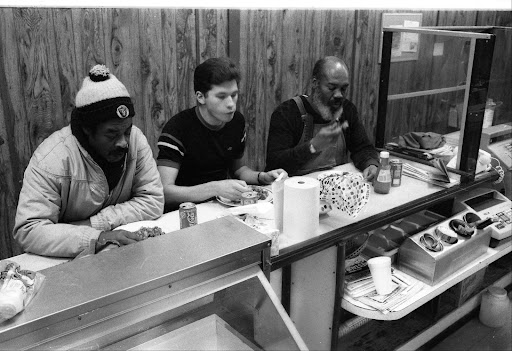I had a discussion with some photo group friends on Saturday about dry mounting and whether it was archival. I found this article online today. The linked site written by photographer Daniel Joder is worth checking out, it has many interesting photography related articles.
http://www.danieljoderphotography.com/is-dry-mounting-an-archival-process/
Is dry mounting an archival process?
By Daniel Joder
It all depends.
It depends on whether you consider just the photograph itself to be the work of art, or if you consider the photograph along with the attached, signed backing board to be the work of art.
If you are party to the first opinion, then dry mounting is not
an option and most museums would also agree. Museums typically consider
the mounting of a photographic print to be archival only if the
photograph itself can be easily removed from its presentation
environment (mat, frame, or whatever) and transferred, all without
suffering damage. Since a dry mounted photograph is very, very difficult
to remove without damage, it therefore isn’t accepted by most museums
as archival (or, to be more precise, it isn’t accepted as an effective
“conservation” method).
If you want to present your images in a way that meets the museum standards of “conservation” and “archival” you obviously must not
press, stick or glue your print to the backing board. Instead, you’ll
need to afix the print with acid-free archival materials that can easily
be removed. Two common ways to do this is are with a V or T hinge or with photo corners .
Having said all this, there are others who claim that dry mounting is
indeed archival and they cite some pretty persuasive reasons. First,
and most importantly, they start with the assumption that it is not just
the print that is the work of art, but the backing board as well–it is
all one unit. Indeed, in many cases, the artist will sign the work just
below the image on the backing board and will often add another
certification sticker or signature stamp to the reverse side of the
board. Obviously, those things are important and integral to the print
itself.
Furthermore, it is also quite simple to choose and use acid-free
materials in all steps of the dry mounting process–from the dry mounting
tissue to the backing board to the outer mat. Many argue that the print
is actually protected from the environment better this way
than with the more loose V or T hinge-type mounts preferred by the
purists. In the latter case, they argue, damaging substances can more
easily get at and eat away at the photograph.
Personally, I prefer the dry mount option. The print lies flat and
will never curl, it can be easily handled even without the top mat in
place, and I also like having the signature on the board (with
additional certification/signature stamp on the back) rather than on the
photograph itself. If the whole unit–backing board and print–is
well-crafted with museum-quality, acid-free, archival materials, (and
quality inks and paper are used in the print) I think it stands a good
chance of outlasting most of us alive today.
What you do will depend very much on the type of photography you do
and which way you decide to go in this “archival debate.” In fact, you
may also decide to do neither. You could, instead, mount your images
with thumbtacks, or on aluminum, cloth, wood, or plastic…or use any
number of other, more imaginative methods of presentation.
This is art, after all…and there really are no rules!
skip to main |
skip to sidebar
I have been thinking of why I love photography, it comes down to something I have labeled "The Three Joys"
1) Creativity
The first joy is simply creating the work. Everything about the making of photographs I love. The initial ideas, the writing on the blog, the preparation of equipment, the research into my subjects, figuring out what I want to communicate. The camera tech stuff like composition, lens selection, cameras, figuring exposure, taking the shot etc. The post darkroom work where you swim with your prints bringing them slowly to life, creating something powerful and beautiful. I love it all.
It is so powerful a thing, you have a idea in your mind, there is nothing else, then YOU make it, you create it, it's fricking awesome stuff.
2) The People
The second joy is that photography has allowed me a way into so many peoples lives, so many different worlds. I get to meet people of all types, speak to them, eat with them, cry and laugh with them. For a while I get to live their existence to be them if you will.
I get to be a child in a slum in Bangkok or a drug addict in a ghetto in Oakland. I get to be a ladyboy sex worker in Pattaya or a man dying of cancer in Canada. Of course I am not really those people but I get a true flavor for those worlds, those experiences, the good and the bad, the ugly and the beautiful, the joy and the sadness.
With photography I get a chance to live outside of the same same everyday meat and potato lives many of my friends and family live. Because I use a camera and make pictures all the doors to a wonderful life experience are open to me, photography is a window into everything!
3) The Photograph
The third joy is about the feeling you get when you accomplish your goals, when you see your final print in the developer, fix or hanging in a gallery. There is a special emotion there, a true satisfied happiness, something so uniquely rewarding. In the darkroom sometimes when I see the finished photo for the first time as it lays in the fixer tray I will let out hoops of joy. I will scream and shout. It is quite a spectacle! It's just the sheer high of that moment bursting out, the YES moment. When the photo is right and you see it for the first time it's the best feeling in the world, better than anything I have ever felt, the high of highs!!
"Ain't Photography Grand!"
"Ain't Photography Grand!!"
Social Documentary Photography for a Better World!
Search This Blog
Contact Gerry Yaum
contact@gerryyaum.net
Gerry Yaum Interview, FRAMES PHOTOGRAPHY MAGAZINE YouTube Channel
"Black & White" Photography Magazine, Issue #160
BLACK &WHITE Magazine, Layout Feature
CENTRE for BRITISH DOCUMENTARY PHOTOGRAPHY, CBDP
St. Albert Gazette MY FATHERS LAST DAYS Story
Me, W. Eugene Smith, Sebastiao Salgado, Lewis Hine and Walker Evans! :) NOT!!!
LUNCHBOX Radio Interview FOR UNB EXHIBITIONS
MONEY EARNED TO HELP THE PEOPLE IN THE PICTURES
Money that will be used to directly help the people in our two photography projects, THE FAMILIES OF THE DUM and THE PEOPLE WHO LIVE UNDER THE FREEWAY $6334.67 ($6000 earned when 6 prints were added to the UNB permanent collection).
GOFUNDME, FAMILES/FREEWAY
Trying to raise $2000 to help the people under the freeway, and the families of the dump. TOTAL RAISED SO FAR = $325 —->$314.67 (after GOFUNDME fees).
UNIVERSITY OF NEW BRUNSWICK EXHIBITIONS VIDEO
Analog Forever Magazine
Vernon Morning Star Newspaper Story
2022 "Families of the Dump"/The People Who Live Under The Freeway Donation Buys
Total donation money spent for the 2022 trip to the Mae Sot dump (THE FAMILIES OF THE DUMP), Bangkok's Klong Toey Slum (THE PEOPLE WHO LIVE UNDER THE FREEWAY). Money spent on "The Families of the Dump" = $571.17 CAD (14982 Thai Baht) Money spent on "The People Who Live Under The Freeway = $144 CAD (3849 Thai Baht) General cases where money was spent to help others in need $15 CAD (401baht)
(Thai Currency) or
CAD
"Families of the Dump" Donation Total
$4420.02 CAD
GERRY YAUM: YouTube Video PHOTOGRAPHY CHANNEL
THE GOAL
To create photographs that speak to the universality, the commonality and the shared humanity of all peoples, regardless of country, race, culture or language.
TRANSLATE YAUM'S PHOTO DIARY INTO YOUR LANGUAGE
Quote: Robert F. Kennedy
“The purpose of life is to contribute in some way to making things better.”
Quote: Nelson Mandela
"As long as poverty, injustice and gross inequality persist in our world, none of us can truly rest."
Quote: Weegee (Authur Fellig)
"Be original and develop your own style, but don't forget above anything and everything else...be human...think...feel. When you find yourself beginning to feel a bond between yourself and the people you photograph, when you laugh and cry with their laughter and tears, you will know your on the right track....Good luck."
Blog Archive
-
▼
2013
(720)
-
▼
February
(38)
- The Work Is What Matters Most
- Another 13 Hour Plus Darkroom Night
- More Portable 4x5 Flash Idea?
- High Of Highs!
- 7 Prints? How Many Can I Do In A Day?
- Kodak Tmax 3200 Discontinued
- Developing 4x5 Sheet Film In A Patterson Tank
- Things Coming Together
- Another Night In The Dark
- Diane Arbus Biography
- More Submissions
- Todays Darkroom Work
- Opening Reception Date Changed
- Super Cool, Got To Try This!
- Quotes: Diane Arbus
- Video: More Youtube Darkroom Vids Added
- 22 Of 35 Show Prints Completed
- Jeffery A Warner Journalism "Life Amidst the Rubb...
- Video: More Mae Sot Garbage Dump Video Links
- Quote: Jeffery A Warner (Photographer And Free Spirt)
- 3 Weeks x 3 Trips
- Quote: Camille Pissarro (Painter)
- Drymounting, Is It Achival?
- Mother And Daughter Photograph First Attemp
- Pushing Hard
- To Many Cameras!
- I Rock!
- Change Of Date For Opening Reception:"The Train Is...
- Shipping Case
- Wish I Had Me One Of These! Digital Enlarger
- Swiss Corner Redux?
- Darkroom Clutter Photos
- Future Vids?
- Video: Darkroom Process, Bleaching, Toning And Was...
- Darkroom Work Video And Digi Photos
- And Yet Another Photo Project Idea
- Things Are Coming Together
- Working Out Towards Making New Photographs
-
▼
February
(38)
Total Pageviews
The Three Joys Of Photography
The Three Joys
1) Creativity
The first joy is simply creating the work. Everything about the making of photographs I love. The initial ideas, the writing on the blog, the preparation of equipment, the research into my subjects, figuring out what I want to communicate. The camera tech stuff like composition, lens selection, cameras, figuring exposure, taking the shot etc. The post darkroom work where you swim with your prints bringing them slowly to life, creating something powerful and beautiful. I love it all.
It is so powerful a thing, you have a idea in your mind, there is nothing else, then YOU make it, you create it, it's fricking awesome stuff.
2) The People
The second joy is that photography has allowed me a way into so many peoples lives, so many different worlds. I get to meet people of all types, speak to them, eat with them, cry and laugh with them. For a while I get to live their existence to be them if you will.
I get to be a child in a slum in Bangkok or a drug addict in a ghetto in Oakland. I get to be a ladyboy sex worker in Pattaya or a man dying of cancer in Canada. Of course I am not really those people but I get a true flavor for those worlds, those experiences, the good and the bad, the ugly and the beautiful, the joy and the sadness.
With photography I get a chance to live outside of the same same everyday meat and potato lives many of my friends and family live. Because I use a camera and make pictures all the doors to a wonderful life experience are open to me, photography is a window into everything!
3) The Photograph
The third joy is about the feeling you get when you accomplish your goals, when you see your final print in the developer, fix or hanging in a gallery. There is a special emotion there, a true satisfied happiness, something so uniquely rewarding. In the darkroom sometimes when I see the finished photo for the first time as it lays in the fixer tray I will let out hoops of joy. I will scream and shout. It is quite a spectacle! It's just the sheer high of that moment bursting out, the YES moment. When the photo is right and you see it for the first time it's the best feeling in the world, better than anything I have ever felt, the high of highs!!
"Ain't Photography Grand!"
Contact Gerry
- Gerry Yaum
- Edmonton, Alberta, Canada
- Email Gerry: gerryyaum@gmail.com
"Can a photograph stop a war? Can it save a life? Can it lead to understanding, inspire someone to help, provide comfort and open the door to compassion?
Hope that it can.
Pray that it can."
Hope that it can.
Pray that it can."










